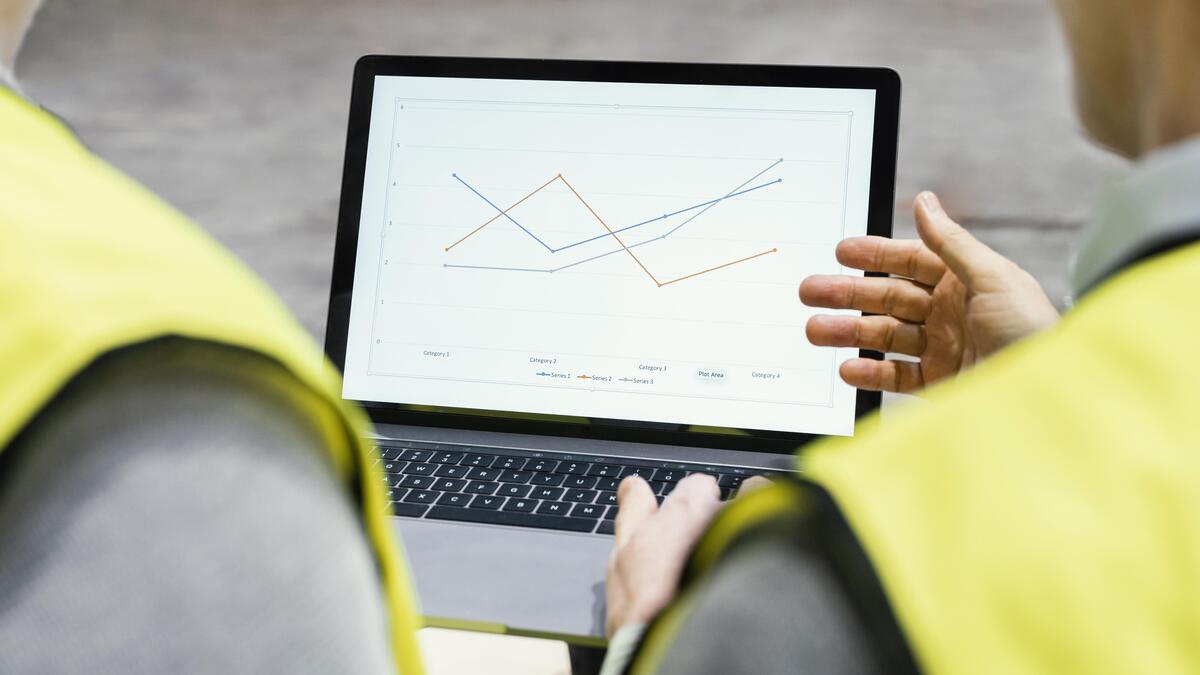Exclusive Neuroject Article: In today’s rapidly altering construction landscape, the pressure to deliver projects on time and within budget is higher than ever. The construction sector has historically been perceived as being resistant to change and depending mostly on antiquated techniques and equipment that, although dependable, may not be the most effective in the current digital era. But there’s an obvious need for innovation as urban sprawl gets worse and infrastructure becomes more and more necessary.
Step into the era of digital transformation, which will bring about more efficiency and streamlined operations. Leading this revolution is digital construction management, an innovative solution that promises to address the most important issues facing the sector.
It is imperative that anybody involved in construction, be it a project manager, contractor, or stakeholder, comprehends the advantages of using digital technologies. They can not only provide notable benefits in terms of cost, time, and resource management, but they can also significantly enhance the way projects are managed.
Digital construction management is changing how companies operate and improving their productivity in the field and in the office. The construction industry is notorious for being slow to adopt new technologies, but failure to digitize your processes in today’s landscape isn’t an option.

Table of Contents
The Evolution of Construction Management
Construction has existed for as long as civilization. Our constructed environment, which spans from the historic pyramids of Egypt to the soaring skyscrapers of modern metropolises, is a monument to the persistent inventiveness and creativity of the human race. However, especially in the last few decades, there have been significant changes to the techniques and resources employed to manage major projects.
Construction management was solely a manual process at first. Handwritten notes and in-person interactions were the main means of communication for foremen who managed large construction sites with little more than drawings and expertise. There was a large margin for error, and relying too heavily on human memory and discernment frequently resulted in expensive errors and delays.
The construction industry started to show the first signs of digitization in the late 20th century. Important computer programs began to help with financial planning and scheduling. However, the construction sector started to genuinely undergo a digital transformation in the 21st century with the introduction of the Internet and cloud computing.
The digital construction management used today is very different from those outdated instruments. Intelligent data analysis, virtual reality simulations, and real-time collaboration are all made possible by integrated systems. building managers now have invaluable allies in the digital tools at their disposal to help them navigate the complexity of today’s building projects.
Knowing this evolution provides an insight into the future rather than merely teaching history. The instruments at our disposal will advance along with technology. To guarantee that projects are finished with accuracy, economy, and originality, those in charge of construction projects need to keep up with these developments and make use of the newest digital construction management tools.
Suggested article to read: Top 21 Digital Transformation Companies
What is Digital Construction Management?
Building is really about realizing a vision. Every construction project, no matter how big or small, begins with a concept. There is a maze of organizing, coordinating, and carrying out work that needs to happen between the first spark and the finished construction. Digital construction management can help with that.
Picture a digital command center that integrates all the minute elements, such as labor schedules and raw material requirements, as well as financial analyses and real-time progress monitoring. That command center is digital construction management, a complete tool meant to make sense of the intimidating complexity of building projects.
The following are some essential elements and characteristics of contemporary digital construction management:
- Centralized Database: No more sifting through piles of paper or multiple spreadsheets. This software provides a single point of access for all project-related information, ensuring everyone’s on the same page—literally.
- Collaborative Tools: Modern construction projects often involve multiple stakeholders, from architects to subcontractors. This software promotes seamless collaboration, allowing real-time updates, feedback loops, and shared access to crucial documents.
- Scheduling and Time Tracking: Gone are the days of manual timesheets and missed deadlines. With intuitive calendar features and time-tracking tools, managers can ensure every project phase stays on track.
- Budget Management: With financial tools integrated directly into the software, project managers can monitor expenses, forecast costs, and ensure the project remains within budget parameters.
- Reporting and Analytics: Data is the lifeblood of any project. Advanced analytics tools offer insights into performance metrics, helping identify areas of improvement and optimize future projects.
Digital construction management is becoming a necessary tool rather than a luxury as the digital age advances. Such tools make sure that businesses can stay ahead of the curve and provide remarkable results with greater efficiency and precision, especially as the construction landscape becomes more competitive and tough.

Top 6 Benefits of Digital Construction Management
Digital solutions are all the rage in the construction industry, and for good reason. The traditional players in the field are looking for solutions that provide more than simply digital copies of labor-intensive manual processes as projects become more complex and customer demands rise. Here comes digital construction management, a feature-rich suite that seems specially designed for the ever-changing construction industry of today. What benefits, though, come with joining this digital bandwagon? Let’s dissect it.
1. Enhanced Project Efficiency
“Efficiency” is a term that all construction professionals can relate to. Projects involve a variety of moving components, such as labor, equipment, and supplies, and coordinating them well is similar to arranging a symphony. That’s where digital construction management comes in, balancing every component to create a work of art like a master conductor.
The sector has experienced its fair share of inefficiencies in the past. Do you recall the day when design modifications would take weeks to spread? or when a single phase’s delay caused a chain reaction that sent the entire timetable off course? Despite becoming all too often, these situations are no longer guaranteed.
The adoption of digital tools has led to several improvements in efficiency:
- Real-time Collaboration: Digital construction management tools allow multiple stakeholders to work in tandem, even remotely. Whether architects make design modifications or site managers update progress, everyone collaborates in real-time.
- Instant Updates: Speed is often the difference between success and stagnation. Instant notifications ensure that changes are swiftly communicated, reducing waiting times and enhancing response speed.
- Unified Workspaces: Gone are the silos. With centralized data storage and access, teams no longer waste time searching for information across different platforms or locations. Everything they need is in one place.
- Predictive Analysis: By harnessing AI’s power, digital construction management software can predict potential bottlenecks or issues, allowing teams to address them before they escalate proactively.
Digital construction management’s ability to reinvent conventional operations is what makes it so beautiful. Processes that used to take days to accomplish are now finished in hours. Error-prone tasks have significantly improved in accuracy. The outcome? projects that are better in quality and finished more quickly.
In a world where time is money, especially in construction, embracing software-driven efficiency is not just an advantage—it’s a necessity.
2. Cost Savings
Keeping expenses under control is always the first goal, regardless of the size of the building. Overspending, unanticipated costs, and inefficiency have long been industrial budgetary banes. However, what if there was a way to lessen or even avoid these financial hazards? A world of digital construction management awaits you.
The cost benefits of using digital tools in the building are revolutionary rather than just marginal. This program opens the door to significant savings in the following ways:
- Error Reduction: While time-honored, manual data entry and calculations are prone to human error. Automated processes within digital construction management tools dramatically reduce these mistakes, saving the costs associated with rectifications.
- Time is Money: Enhanced efficiency, as we’ve discussed, speeds up project timelines. Quicker project completion directly reduces labor costs, equipment rental fees, and overheads.
- Resource Optimization: The software provides a clear view of resource allocation, ensuring that workforce and machinery are used effectively, preventing costly idle times or overbookings.
- Waste Minimization: Precise material estimations and inventory management features cut down on wastage, ensuring that every penny spent on resources is utilized to its maximum potential.
- Predictive Insights: The digital construction management tool can forecast potential financial pitfalls by analyzing historical data and current trends, enabling teams to make informed decisions and sidestep costly surprises.
- Transparent Financial Tracking: Real-time access to all financial aspects of a project—from invoices to change orders—ensures that managers can monitor budgets closely, making adjustments as needed to stay on track.
Having a strong digital construction management tool can be the difference between a financially disastrous project and a profitable one in the ever-changing world of construction, where material prices are subject to sudden changes and unforeseen expenses might arise at any time. It takes wise, knowledgeable financial stewardship to make sure every dollar invested generates the highest return; it’s not just about squeezing pennies.
3. Real-time Access to Data
One thing is very evident in the digital age: data is king. In the fast-paced construction industry, where decisions are sometimes made on the spot and projects change quickly, timely access to reliable data is not only a luxury but a need. This is when the real value of digital construction management is seen.
For a moment, let’s go back to the times before digital integration. Remember those late nights awaiting project updates? The tense waiting times during which teams awaited critical information, such as modifications to the design, the availability of resources, or adjustments to the budget? Fortunately, such days are fading into the past.
Real-time data availability has a significant impact on the construction industry:
- Informed Decision Making: Instant access to updated information means project managers and stakeholders can make decisions that are timely and based on the most current data available, reducing the chances of costly errors.
- Enhanced Collaboration: Real-time data sharing allows on-site or remote teams to collaborate efficiently. An architect’s design tweak is instantly available to the engineer, and stakeholders can view a site manager’s update in a boardroom across the city.
- Time-Saving: With data at their fingertips, teams no longer waste valuable time searching for files or waiting for updates. This accelerates the project timeline and ensures efficient use of resources.
- Risk Mitigation: Instant insights into project progress, resource allocation, and financial metrics help in the early identification of potential risks. Early detection often means early resolution.
- Client Satisfaction: For clients, staying informed is a primary concern. With real-time data access, they can monitor project progress and get immediate answers to queries, leading to heightened trust and satisfaction.
Project teams are essentially given a superpower by digital construction management’s real-time access, which enables them to view, comprehend, and take action on every aspect of the project as it develops. This real-time view of data is revolutionary in an industry where accuracy in detail and promptness in execution are critical success factors.

4. Improved Risk Management
All professionals involved in construction understand that every project, no matter how big or little, has its own set of unique risks and obstacles. Risks abound in the construction industry, ranging from unforeseen weather events and supply chain interruptions to inconsistent design and safety issues. But what if there were instruments that could both identify and help manage these risks? That is the magic that digital construction management offers.
Entering the construction industry without a well-thought-out risk management strategy is like trying to navigate choppy waters without a map. Although there may be some storms along the way, there are many possible calamities. Here are some examples of how the program is essential for navigating these choppy waters:
- Predictive Analysis: Utilizing the power of AI and machine learning, the digital construction management software evaluates project data to forecast potential challenges. This might range from predicting a shortage of certain materials based on market trends to anticipating potential workflow bottlenecks.
- Safety Protocols: Safety first! The software ensures that safety standards and protocols are adhered to, minimizing the potential for on-site accidents and the associated financial and legal repercussions.
- Document Consistency: With real-time updates and centralized document management, there’s a drastic reduction in the chances of teams working off outdated or inconsistent data, a standard risk in large-scale projects.
- Budget Oversight: Financial risks can be just as damaging as physical ones. Digital construction management constantly oversees budgets, alerting managers to potential overruns or discrepancies and allowing timely interventions.
- Stakeholder Communication: Keeping all stakeholders in the loop is crucial. Improved communication tools mean everyone, from clients to subcontractors, is aligned on project expectations and potential risks.
- Resource Allocation: Digital construction management can flag potential shortages or over-allocations by tracking and analyzing resource usage, preventing costly last-minute scrambles or project delays.
Risks are the threads that have the power to either unravel the entire design or weave a masterpiece into the larger picture of a construction project. Digital construction management performs the role of an expert craftsman, making sure that every line is carefully put and tracked, resulting in a timely and excellently finished job.
5. Transparent Communication
Imagine arranging a football game where players are unable to communicate their movements to one another. Unrest, huh? Without effective channels of communication, construction projects feel like that. Transparency is not just desired, but necessary in a field where even a small misunderstanding can cause serious time and financial setbacks. That’s the exact clarity of communication that digital construction management offers.
The days of communication being limited to a flurry of paperwork, missed conversations, or protracted email exchanges are long gone. The emergence of digital tools has revolutionized communication in the construction industry. A sample of the transparency that this software brings about is as follows:
- Unified Platforms: Digital construction management acts as a one-stop communication hub. Everyone interacts on the same platform, from architects and engineers to clients and contractors, ensuring no details get lost in translation.
- Real-time Updates: Immediate notifications ensure that any changes, whether design modifications or schedule shifts are instantly communicated to all relevant stakeholders.
- Feedback Loops: Feedback is gold in construction. Digital construction management enables instant feedback, ensuring issues are addressed promptly, designs are refined, and the project stays on track.
- Document Sharing: No more hunting for that elusive file or blueprint. Centralized document management means that all relevant files are available to authorized team members at the click of a button.
- Task Assignments: Clear delegation is the cornerstone of smooth operations. Managers can assign tasks, set deadlines, and monitor progress in real time, ensuring accountability and efficiency.
- Client Portals: Keeping clients in the dark is a recipe for dissatisfaction. Specialized client portals allow them to track project progress, view updates, and communicate queries, fostering trust and collaboration.
Digital construction management software facilitates transparent communication, which goes beyond simplifying exchanges to include creating a climate of clarity, cooperation, and trust. In a world where a single misunderstanding may ruin months of diligent labor, having a tool that guarantees everyone agrees is not only advantageous but crucial.
6. Streamlined Document Management
The deluge of paperwork generated by building projects is, if anything, a given. Documents such as change orders, contracts, permits, invoices, and blueprints appear never-ending. Furthermore, every document is essential to the smooth functioning of the project. But what occurs when teams make use of out-of-date designs or a crucial file disappears? No project manager wants to deal with that snag. By using digital construction management, you may avoid being overwhelmed by paperwork.
Modern digital tools have revolutionized document management in ways that cannot be overstated. This is when the program has an advantage:
- Centralized Storage: Forget sifting through heaps of paperwork. All documents are stored in a centralized digital repository, ensuring easy access and retrieval anytime, anywhere.
- Version Control: There’s no greater nightmare than realizing midway that the team is working off outdated plans. The software ensures that everyone accesses the latest version of every document, preventing costly reworks.
- Access Control: Not every document is for everyone. Customizable access permissions ensure that only authorized personnel can view or modify specific files, maintaining confidentiality and security.
- Digital Signatures: Speed up the approval process with e-signatures. Whether greenlighting a design change or validating a contract, digital signatures eliminate delays.
- Backup and Recovery: The fear of losing crucial documents is real. Cloud-based storage and backup functionalities ensure recovery is just a click away with digital construction management, even if something is amiss.
- Integration with Other Systems: Seamlessly sync your document management with systems like accounting or procurement. This holistic integration means fewer manual data entry and reduced errors.
Using digital construction management to manage papers is like always having a well-curated digital library at your fingers. In a location where changes are simple, retrievals happen instantly, and each file has its own spot. This simplified method is nothing short of revolutionary in a field where document integrity can make or ruin a project.

Real-world Case Studies
Tales from the trenches always resonate the most, Real-world tales, in which the theoretical advantages of digital construction management are realized and obstacles are overcome, have an indisputable charm. Let’s explore a few inspiring stories from the construction industry.
1. Skyscraper Symphony
With every square inch of land bearing witness to architectural genius in the heart of New York, the Skyscraper Symphony project aimed to reshape the city’s skyline. This wasn’t only about building upwards, with its lofty objective of 70 stories; it was also about leaving a legacy.
The Backdrop: The skyscraper’s location between famous buildings was both a challenge and an opportunity. A small area with a lot of urban activity required precise logistics execution. On the other hand, winning here would mean leaving a lasting impression on one of the most recognizable cityscapes in the whole globe.
The Challenge: Beyond the towering height, the complexity was multifaceted. It was critical to make sure that different teams—from welders to architects—coordinated seamlessly. Errors could be made that could cost money and effort because the conventional paper trail of logs and designs moved too slowly.
The Software Solution: It was not only necessary but also a choice to use digital construction management. The system offered:
- Real-time Collaboration: Stakeholders could instantly access, edit, and provide feedback on digital blueprints, ensuring everyone was always on the same page.
- Resource Optimization: With instant data at their fingertips, the team could dynamically allocate resources, preventing bottlenecks and ensuring smooth operations.
- Progress Tracking: Daily updates, captured through digital construction management, ensured that project managers had a holistic view of the construction’s pulse, allowing for proactive decision-making.
The result was that the Skyscraper Symphony stood tall not just as a physical building but also as a tribute to the strength of digital change in the construction industry against the backdrop of congested New York traffic and ever-changing weather patterns. The building, which was completed two weeks ahead of schedule and with considerable cost savings, is a towering structure that reflects the power of digital construction management in the glimmer of its glass panels.
2. The Green Park Project
The Green Park Project, tucked away in a charming European valley, was about more than just constructing houses—it was about creating an ecology. This wasn’t built in the conventional sense; rather, it was a pledge to live sustainably and balance modernity and the environment.
The goal is to establish a residential community where environmental awareness is a core value rather than an afterthought. The architectural philosophy was to reduce carbon footprints while optimizing future residents’ quality of life, and it boasts expansive views of undulating green hills.
The Challenge: There were particular difficulties in creating an eco-paradise. The waste and inefficiencies that come with using typical building techniques just wouldn’t work. The project’s ecological ethic had to be adhered to by every brick put and beam raised, and precise material allocation was crucial.
The Benefit of Software: The adoption of digital construction management served as a link between the ideal and the actual. Utilized key characteristics included:
- Precise Forecasting: By leveraging the software’s predictive analytics, the team could gauge exact material needs, ensuring minimal wastage.
- Integrated Communication: As design adjustments emerged, real-time communication tools within the platform ensured that all teams adjusted in tandem, negating costly reworks.
- Sustainability Metrics: The software provided tools to track and measure the project’s environmental impact, enabling data-driven eco-friendly decisions.
The result was the Green Park project, rising elegantly against the verdant environment of Europe, is a model of sustainable building. Material waste was drastically decreased by 15%, and operating efficiency increased by 20%. More than just a housing development, it serves as a prototype for environmentally responsible projects in the future, highlighting the revolutionary potential of digital construction management in a field that is always changing.
3. The Riverside Revival
With the Riverside Revival project, an endeavor was started in the middle of a vast urban landscape where concrete frequently muffles the sounds of nature. The goal was to turn this once-neglected riverfront into a bustling urban oasis with a mix of commercial, residential, and recreational spaces.
The idea is to wake up to the peaceful sounds of a river, have coffee in a busy cafe, and then jog through lush green spaces—all of which are conveniently close to your city flat. This ambition was to be realized through the Riverside Revival, which redefined urban living.
The Difficulty: It required careful balance. The project had to respect the river’s sacredness, conserve the ecology, and meet the infrastructure needs of a multipurpose development. Time was of the essence, as urban migrations meant eager eyes were waiting for project completion.
The Digital Edge: Using digital construction management changed everything. The system allowed for:
- Environmental Oversight: Ensuring the river’s health was a priority. The software aided in monitoring environmental metrics and ensuring adherence to guidelines.
- Dynamic Scheduling: With various aspects of construction occurring simultaneously, real-time scheduling adjustments prevented overlaps and ensured fluid progress.
- Stakeholder Communication: From city officials to future residents, the platform was a hub for updates, feedback, and consultations.
The result is a tribute to urban redevelopment in the modern era: the Riverside Revival. It is a busy neighborhood where kids play by the river, people enjoy the harmony between the city and the natural world, and cafes provide fresh brews while offering vistas. The efficient operation of digital construction management behind the scenes was crucial to making sure the project ran as smoothly as the river it honored.

4 Great Tools for Digital Construction Management
When the decision is made to embrace digitalization and look to the future, it quickly becomes evident that a wide range of solutions are available to enhance workflows and increase productivity.
1. Archisnapper
This on-site snagging tool is intended to reduce the amount of time spent on site reports, follow-ups, and inspections. Architects, engineers, contractors, and safety specialists are the target audience. It allows you to take direct notes of problems while they arise and generates snag/punch lists that are automatically shared with others.
A report’s level of information can be greatly increased by including drawings and images, which will improve its usefulness for decision-making. Paper checklists can be transformed into digital inspection forms, which eliminates the need to chase after dropped paper documents via windy conditions.
2. LetsBuild Planning
a potent tool that helps project managers make decisions quickly. This allows you to import your project plan into a real-time, dynamic environment. Following that, information received directly from the location is updated in the schedule, negating the need for follow-up calls and SMS. Integrating it with existing systems is simple because it is designed to interface with other planning tools such as MS Project, Primavera, Asta Powerproject, and others. You may prevent information overload and focus on the things that matter to you by removing irrelevant information.
3. FieldChat
This instant messaging program organizes, centralizes, and searches conversations for contractors and subcontractors. Teams may occasionally receive an excessive amount of information through group chats and traditional messaging. However, FieldChat allows users to limit access to only the channels they require, keeping interactions relevant and managed. You can use the site broadcasts option for truly critical announcements. With the app, you may submit images to your digital construction management tool and browse project directories.
4. Autodesk BIM 360
From design to construction, this is a single platform that links your project teams and data in real-time. To keep costs under control and deadlines met, the goal is to anticipate safety risks, proactively monitor quality, automate tasks, and minimize rework. Is there anything more a project manager might want?

How to Find the Right Digital Construction Management Tool
Choosing the appropriate instrument might mean the difference between creating a work of architectural art and witnessing a project fail miserably. Choosing the correct digital construction management tool is like choosing the perfect cornerstone for a structure in the digital age, as technology permeates every aspect of our lives. It must be robust, dependable, and customized to meet your specific requirements. If you find yourself in this situation, the following will serve as your road map:
- Understand Your Needs: Before diving into various software options, introspect. Are you seeking better budget management, enhanced collaboration, or real-time reporting? Define your priorities.
- User-Friendliness: A tool is only as good as its usability. Ensure the software interface is intuitive, reducing the learning curve for your team.
- Customizability: Every construction project is a unique entity. Your digital construction management tool should be flexible enough to mold itself to the contours of your project’s demands.
- Scalability: As your projects grow in size and complexity, digital construction management should scale seamlessly. Investing in a scalable solution ensures it remains relevant across various projects.
- Integration Capabilities: Does it play well with other tools you use? Integration with other systems—like finance software or HR platforms—can streamline operations further.
- Security and Compliance: We touched upon the importance of security earlier. Ensure the software meets the latest cybersecurity standards and meets industry regulations.
- Customer Support: Even the best tools can throw a curveball. Opt for software backed by robust customer support, ready to assist when you hit a snag.
- Price Point: While you shouldn’t compromise on essential features, ensuring the software offers value for money is vital. Compare various options, weighing their pros against their price tags.
- Testimonials and Reviews: Word of mouth remains powerful. Seek out testimonials or online reviews. Real-world experiences can offer invaluable insights into a product’s performance.
- Demo and Trial Period: Most reputable vendors offer a demo or trial period. Use this opportunity to gauge the software’s fit for your operations. Dive in, test the waters, and make an informed choice.
Selecting the appropriate digital construction management tool requires more thought than simply checking boxes. It’s about finding a companion to help you navigate the ups and downs of the construction industry. Just managing and becoming an expert in the art of construction is not your only objective as you sort through your possibilities.
Trends and Innovations in Digital Construction Management
The construction management sector is changing quickly due to technological breakthroughs, so it’s critical to comprehend where this subject is headed. The following are the top anticipated developments and trends in digital construction management:
Building Information Modeling (BIM)
The current trend of Building Information Modeling (BIM) will not go out of style. It symbolizes a project involving digital infrastructure or buildings. It facilitates communication and decision-making between engineers, architects, and building specialists.
Moreover, BIM enables participants to build an extensive, virtual model of a construction project. This covers timetables, cost projections, 3D graphics, and additional data. This computerized model is useful for everything from design and planning to building and upkeep.
When it comes to digital construction management, BIM is superior to traditional building approaches in several ways.
- It reduces errors and inefficiencies. So, stakeholders can identify and resolve potential issues before construction begins. This leads to significant cost savings and improved project outcomes.
- BIM enables more efficient communication and collaboration among project stakeholders. Architects, engineers, contractors, and clients discuss an assignment as they view its progress.
- It optimizes construction processes and increases efficiency. This enables shorter timelines and minimized costs.

Construction Robotics
Using robots and automated equipment to carry out construction activities is known as construction robotics. These robots are useful in digital construction management because;
- They perform tasks better than human workers. This reduces project timelines and costs.
- Robots and automated machinery handle dangerous or difficult tasks for human workers. It’s an excellent way of improving safety on construction sites.
- Construction robotics improves quality and accuracy, leading to better project outcomes.
Bricklaying robots are one type of construction robotics that lays bricks more quickly. In addition, safe robots exist for tearing down buildings and other structures. We may anticipate seeing more of these in buildings in the future.
Drones
Drones have revolutionized and will continue to transform construction project planning and execution. An unmanned aerial vehicle (drone) is used to take aerial video. A survey claims that the second-largest industry for drone adoption is construction.
UAVs increase productivity and safety in building projects. They produce precise three-dimensional (3D) representations of building sites for project design and planning.
Additionally, drones monitor building development and give project managers up-to-date information. This enables them to recognize and resolve any problems as soon as they occur.
Reducing the need for manual inspections is one of drones’ main benefits. This is usually expensive, time-consuming, and risky.
Construction managers use drones to survey sections of the site that are difficult to access. It encompasses high-rise structures and rooftops without endangering employees. More over?
A UAV’s ability to detect possible dangers contributes to the safety of building sites. Drones, for instance, can monitor worker activity and warn workers of falling debris.
Learning drone operation might be facilitated by enrolling in digital construction management courses. This enables you to produce reliable information while working from any location.
Suggested article to read: The Importance of Drones in Construction: 7 Key Reasons
Artificial Intelligence and Predictive Analytics
Predictive analytics and artificial intelligence are here to stay. They utilize cutting-edge technologies in their planning, execution, and decision-making processes. This covers budgeting, resource allocation, and project timelines.
AI creates algorithms for computers to carry out operations that require human intelligence. These kinds of jobs involve pattern recognition and prediction.
Artificial Intelligence (AI) is used in digital construction management to analyze project data and offer performance insights. This helps managers decide on projects more intelligently and achieve better outcomes.
Predictive analytics also makes use of machine learning and statistical methods. All of this is done to analyze data and forecast future occurrences. Additionally, it projects project performance, timetables, and costs. This aids managers in recognizing problems and addressing them before they arise.
Project managers can identify possibilities and dangers for their projects by using AI and predictive analytics. Consequently, they increase profitability and produce superior project outcomes.
Suggested article to read: Artificial Intelligence or AI in Construction Industry; Guide to 2023
Conclusion
In the ever-evolving world of construction, the stakes are high. The requirement for efficient and effective construction management is ubiquitous.
This is especially true for large and complicated construction projects where project managers, superintendents, senior executives, and owner-operators are continuously looking for innovative solutions to streamline procedures, boost efficiency, and guarantee successful project completion.
Construction management has entered a new phase with the introduction of digital technology. The way we plan, monitor, and carry out construction projects is changing drastically in the modern era thanks to innovative tools and technologies.
Construction management appears to have a bright future because of several emerging trends and technologies. The construction business is changing as a result of these developments and trends. They enhance effectiveness, safety, and sustainability while offering fresh answers to enduring issues. Therefore, to stay competitive, industry experts need to be informed.
Accepting these innovative methods can help you save expenses and achieve better results. This is what propels success in the building sector.
Digital technologies in construction can be a massive leap forward for the construction industry if companies would be willing to commit to it, to admit that issues exist, and this can be a way to fix them.
Adopting completely new technology can, of course, be a very costly undertaking, particularly for larger organizations, but eventually, the project benefits will make that investment worthwhile. Given how much money and effort the building industry has been losing for decades, the “sooner” element might also happen faster than businesses may anticipate.
Suggested article for reading:
Important Construction Technology in 2023
What is Digital Transformation & Why is it Important?
Resources:
Revizto | E-builder | Hitachi-Solutions | Locusview | Indeed | Linkedin | Deloitte | Coruzant | Traxxeo | Bigrentz | Lets Build | Forconstructionpros | Project Manager | Zynka | Planradar | Autodesk | Disperse | Bauwise
For the pictures: Freepik



